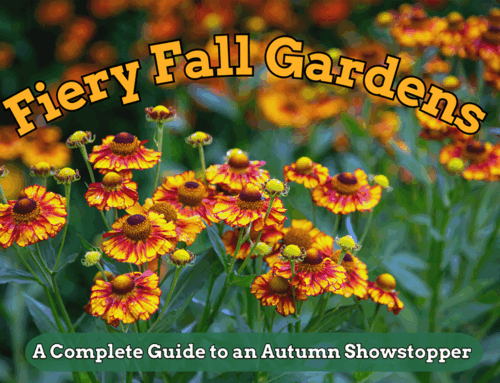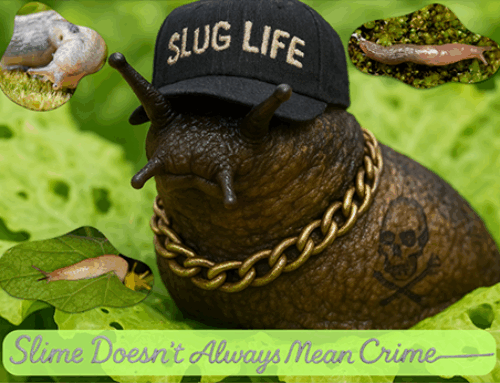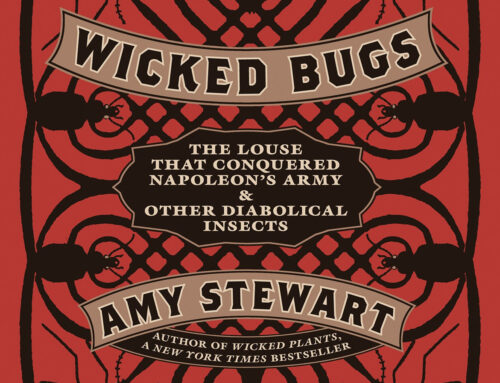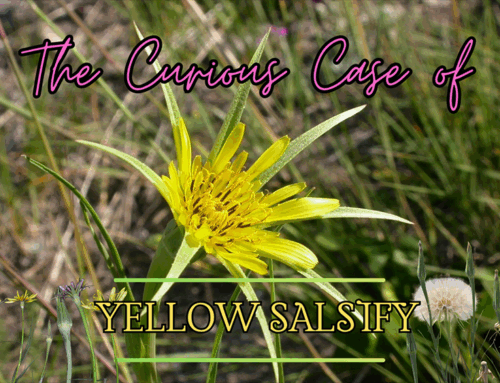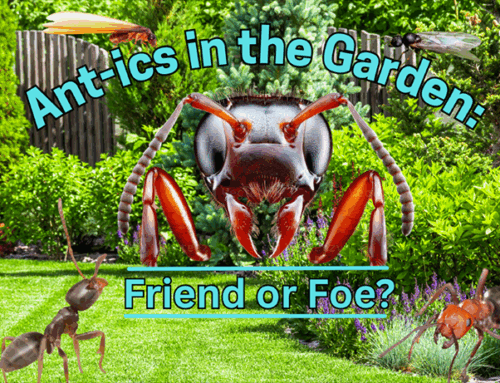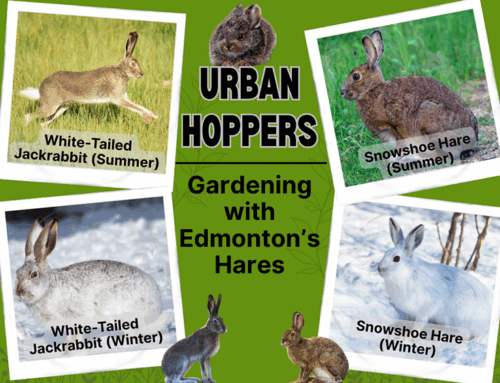Lawn and Order: Skunks on Patrol
by Brett Kerley
There are few garden visitors as unmistakable as skunks. With their striking black-and-white stripes, cat-like size, and slow, rolling walk, skunks are both endearing and exasperating. Edmonton is home to the striped skunk (Mephitis mephitis), and while it rarely means serious harm to the garden, its nocturnal habits can leave a lawn looking like it has been through a small war.
For gardeners, understanding skunks—their life cycle, habits, and role in the ecosystem—can make the difference between seeing them as villains or simply as quirky neighbours with a rather unfortunate form of self-defence.
Meet the Striped Skunk
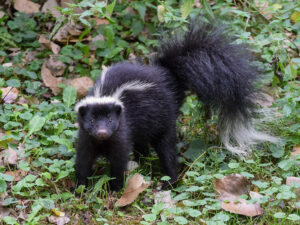
Striped Skunk (Mephitis mephitis)
The striped skunk is about the size of a domestic cat, measuring 50–80 cm (20–32 inches) in length, including its luxuriant tail, and weighing between 2–6 kg (4–13 lbs). Its bold white stripes serve as a warning: this is not a creature to trifle with.
Despite their fearsome reputation, skunks are mild-mannered. They do not attack unprovoked and usually prefer to avoid confrontation altogether. If cornered, however, they will give fair warning: first by stamping their feet, then by raising their tail. If the threat continues, they may unleash their notorious spray—an oily musk containing sulphur compounds that can travel up to 3 metres (10 feet). The smell can cling to fur, clothing, or skin for days if not properly treated.
Skunk Life Cycle

newborn skunks
Skunks are mostly solitary creatures, except during mating and when a mother is raising her young. Their year looks something like this:
- Late Winter/Early Spring (February–March): Mating season. Males wander widely in search of females.
- Spring (May–June): Females give birth to litters of 4–7 young, called kits, in burrows or dens beneath sheds, porches, or brush piles. The kits are born blind and helpless but grow quickly.
- Summer (June–August): Kits follow their mother on foraging trips, learning to dig for grubs and other prey. This is often when gardeners notice small family groups moving about at dusk.
- Autumn (September–November): Skunks feed heavily to build up fat reserves for the winter. They eat insects, fallen fruits, small rodents, and even the occasional frog or bird’s egg.
- Winter (December–February): Skunks do not hibernate fully but enter a state of semi-dormancy. They will spend long periods asleep in dens, often several females together, though males are more solitary.
In the wild, skunks usually live 2–4 years, though predators such as owls, foxes, and vehicles on Edmonton’s roads keep populations in check.
What do Skunks Eat in the Garden?
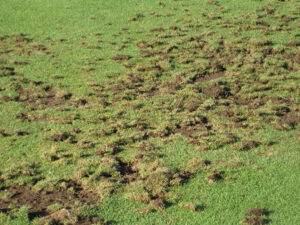
Skunk damage in a lawn
Skunks are opportunistic omnivores, which means their menu changes with the seasons and whatever is easiest to find. While they’re not the worst garden marauders compared to deer, rabbits, or voles, their eating habits can still make an impact.
Insects and Grubs (Their Favourites)
- White grubs (the larvae of June beetles and chafers) are a skunk delicacy. This is the main reason you’ll see lawns dug up in the spring and summer.
- Beetles, crickets, and grasshoppers are also popular snacks.
- Wasp and hornet larvae—skunks will dig into ground nests to scoop out the juicy larvae, which makes them surprisingly helpful at controlling stinging insects.
For gardeners, this is a double-edged sword: skunks do great pest control, but their method of “aerating” the lawn is less than elegant!
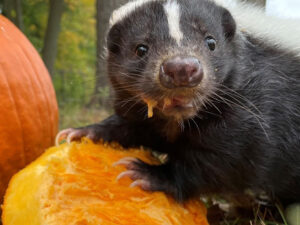
Skunk eating
Fruits and Vegetables
Skunks aren’t big plant eaters, but they’ll happily munch on a few things if they’re accessible:
- Sweetcorn: They’ll go after the lower cobs once they ripen.
- Berries: Strawberries, raspberries, and blackberries are fair game, especially fallen fruit.
- Melons and pumpkins: Occasionally sampled if they’re soft and ripe.
- Garden peas: Sometimes targeted, especially if pods are low to the ground.
Fallen Produce
Skunks are scavengers, so anything that drops to the soil—windfall apples, plums, or tomatoes—may get snacked on during their nightly rounds. Gardeners often mistake this damage for raccoons, but skunks are slower, more methodical feeders. And yes we do have racoons here in Edmonton! They’ll also clean up spilled seed under bird feeders.
Small Animals and Other Prey
- Rodents: Mice and voles are sometimes eaten, though skunks aren’t fast hunters.
- Frogs and toads: Snatched if the opportunity arises.
- Bird eggs: On rare occasions, they may raid nests on or near the ground.
What They Don’t Usually Bother With
- Root vegetables like carrots and potatoes are generally ignored (unless insects inside attract them).
- Most leafy greens and ornamental plants are safe from skunk nibbling.
Are Skunks Helpful or Harmful in the Garden?
In many ways, skunks are more helpful than harmful in the garden: they reduce populations of damaging grubs, beetles, and wasps. The real frustration for gardeners comes from their enthusiastic digging, not their dining.
If you wake up to shallow holes scattered across your flowerbeds or lawn, you can be almost certain that a skunk was feasting on grubs overnight. And while this “pest control” is effective, most of us would prefer they dine a little less vigorously!
Preventing Skunk Damage in the Garden
The best way to discourage skunks is to remove the things that attract them.
- Control grubs: Apply beneficial nematodes or milky spore disease to lawns and borders in spring. This reduces grub populations, making your garden less appealing to skunks.
- Secure food sources: Do not leave pet food or rubbish outdoors overnight. Skunks will happily raid bins if given the chance.
- Block entry points: Skunks like to den beneath porches, decks, sheds, and woodpiles. If you discover a den, wait until you are certain it has been vacated (usually after dark), then block the entrance with soil or wire mesh. To encourage them to leave, place rags soaked in household ammonia near the opening.
- Trapping and relocation: If a skunk has taken up residence and refuses to leave, trapping may be necessary. In Edmonton, this is best left to professional wildlife control services to avoid both legal issues and unfortunate spraying incidents.
What To Do If Your Pet Gets Sprayed?

Ready to spray
Most gardeners are less worried about digging and more concerned about the infamous spray. Pets, particularly dogs, seem incapable of resisting the urge to investigate skunks, often with disastrous consequences.
Immediate Action:
- Keep the affected person or animal outside to avoid bringing the smell into your home.
- Forget tomato juice — it doesn’t work. (Jane’s note: I tried it once, before I knew better: result: angry, sticky cat that still smelled bad)
The Tried-and-True Solution:
Mix the following fresh:
- 1 litre (1 quart) of 3% hydrogen peroxide
- 60 ml (¼ cup) bicarbonate of soda (baking soda)
- 5 ml (1 teaspoon) washing-up liquid (dish soap)
Lather your pet in this mixture and wait five minutes, then rinse with copious amounts of water. Repeat if necessary. It is possible this may bleach your pet’s fur, but it is not toxic to their skin. Note that this mixture doesn’t store well, so you will need to make a fresh batch if your pet gets sprayed again. Never put this mixture in a closed container, it can fizz up and explode!
If your pet’s eyes seem to be affected, rinsing them with copious amounts of tepid water for 20 minutes may relieve some discomfort.
Skunks can be carriers of rabies. If you suspect your pet has been bitten by a skunk, it is best to contact a veterinarian right away. Also, make sure your pet is vaccinated against rabies.
Living With Skunks
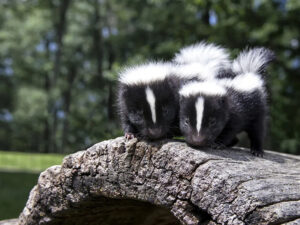
Striped skunk kits
Although they may cause frustration, skunks are not villains. They play an important role in keeping insect populations in check, and their presence is a sign of a healthy, balanced urban ecosystem. With preventative measures, gardeners can avoid most conflicts.
If you do find yourself sharing your Edmonton garden with a skunk or two, try to see them as slightly eccentric neighbours—quiet, mostly harmless, but prone to the occasional dramatic outburst. With a bit of patience and good humour, you can live alongside them without too much trouble.
And remember: if you ever meet one face to face in the twilight, the best gardening tool at your disposal is a quick retreat in the opposite direction!
Wishing you fragrant flowers, not fragrant fiascos.


